Among the most famous Etruscan sarcophagi is certainly possible to include those preserved at the Museum of Fine Arts in Boston. These are two masterpieces depicting as many couples, lying in bed, and caught in a moment of affectionate intimacy: the older one depicts Arnth Tetnies and his wife Ramtha Vishnai, while the other one shows the couple’s son, Larth Tetnies, together with his wife Thanchvil Tarnai (the names of all four are known as they are given in the inscriptions on the two sarcophagi). They were discovered in a necropolis at Vulci in the 1840s, in what were then the possessions of the princess of Canino, Alexandrine de Bleschamp, Napoleon’s sister-in-law. The noblewoman’s heirs managed to sell them a few years later, and after making other changes of ownership, they were then purchased by the Boston museum in 1886: they have been in the United States since that date. They are among the most famous works of Etruscan art precisely by virtue of their exceptionality: there are no other similar works depicting couples embracing, and they enable us to glean a variety of information aboutlove in ancient Etruria.
Particularly extraordinary is the sarcophagus of the younger couple, whose degree of fineness and naturalism (greater than that which transpires from the sarcophagus of Arnth and Ramtha) suggests that it is the work of a Greek artist (not least because the hairstyles of both spouses reflect Greek fashions): we see Larth and Thanchvil gazing intensely into each other’s eyes, both are naked, and presumably about to join in intercourse. What strikes us most in looking at the two works are precisely the gestures and glances that the characters exchange: the two caress each other, and they appear fully satisfied with their relationship. The woman is not passive as is often the case in the erotic figurations of antiquity (although, in this case, the eroticism is only suggested): in fact, she is fully participating and responding to her husband’s affectionate attentions (and the same is true of the other sarcophagus). Everything in the sarcophagus of Larth and Thanchvil exudes sensuality: one need only observe, under the fine sheet rendered with such lightness and skill as to allow the shapes of the bodies to be glimpsed, the thighs of the two brushing up against each other and about to come together. The mouths of the two lovers are about to join in a kiss, and the fact that her left hand begins to slide downward hints at what will happen shortly thereafter.
Different, however, is the inkling that pervades the sarcophagus of Arnth and Ramtha. There is no eroticism there; the position of the bodies suggests no union. There is, however, intimacy, complicity, deep awareness of the love that unites the two spouses. Although it is difficult to speak of equality between the two sexes (we do not know what the legal status of the spouses was among the Etruscans), from this image, as well as from other marital images that have survived (such as the Sarcophagus of the Spouses at the National Etruscan Museum of Villa Giulia in Rome, or the equally famous Urn of the Spouses at the Guarnacci Museum in Volterra), it is possible to infer that the distance between men and women in relationships was, among the Etruscans, much less marked than that which characterized other ancient civilizations. However, what is certain is that the woman must have enjoyed a leading role within the couple, and was not merely subjected to her husband’s behavior.
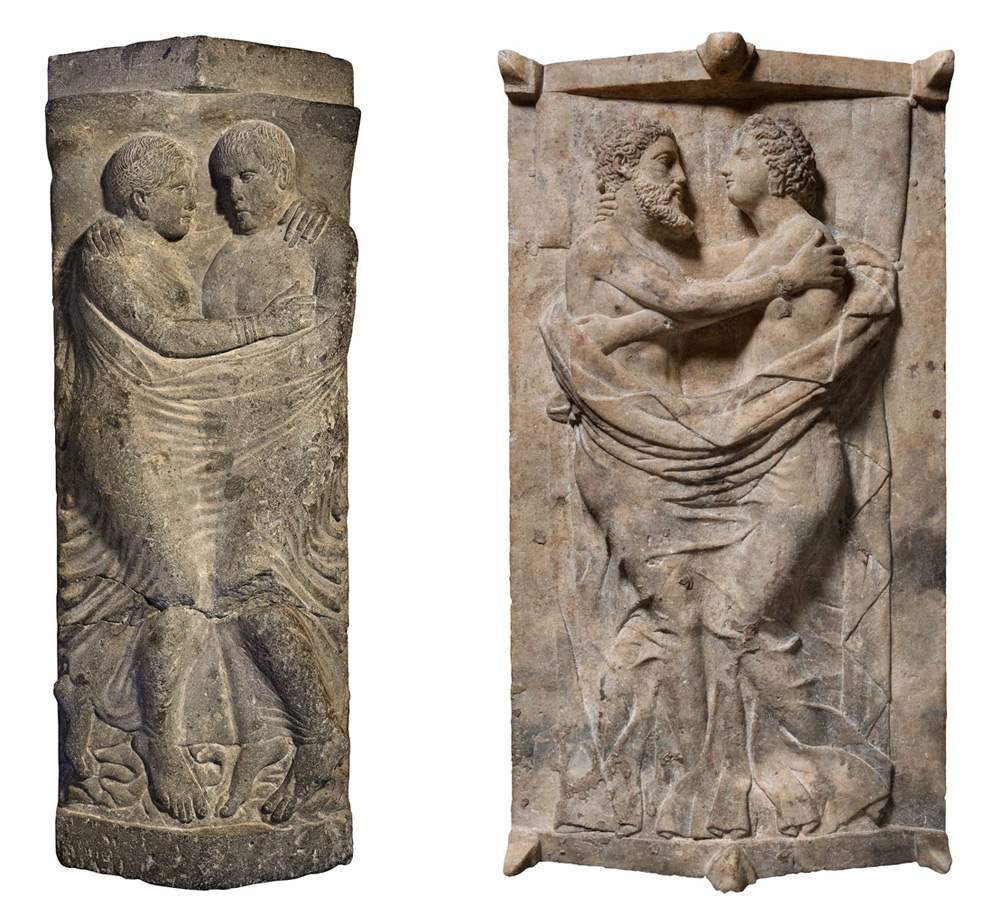 |
| Left, sarcophagus of Arnth Tetnies and Ramtha Vishnai. Right, sarcophagus of Larth Tetnies (late 4th to early 3rd century BC; stone, 88 x 73 x 210 cm; Boston, Museum of Fine Arts) and Thanchvil Tarnai (350-300 BC; stone, 93.3 x 117.4 x 213.8 cm; Boston, Museum of Fine Arts) |
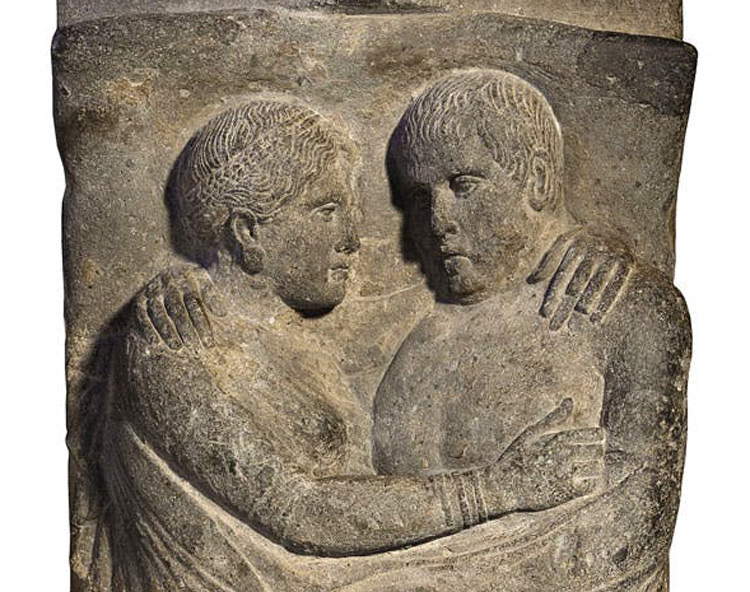 |
| Detail of the sarcophagus of Arnth Tetnies and Ramtha Vishnai |
 |
| Detail of the sarcophagus of Larth Tetnies and Thanchvil Tarnai |
The two sarcophagi from Vulci are the only remaining visual evidence of conjugal love among the Etruscans. More widespread, however, are depictions of carnal love and explicit sexual intercourse between different subjects. The journey into the world of sex according to the Etruscans can begin in Tarquinia, and to be exact in the necropolis of Monterozzi, where some of the most celebrated erotic scenes in Etruscan art are found. In the Tomb of the Bulls, whose frescoes can be dated to the sixth century B.C., we see depictions of two sexual relationships, one of which is a threesome. The ménage à trois, between two men and a woman, takes place in a very peculiar position: one of the two men is kneeling on the ground, holding himself on his forearms. The woman is lying supine over his back, and the third man, standing, is penetrating her by holding her legs up. Behind, there is a bull who seems completely indifferent to what is taking place beside him. The other scene, on the other hand, depicts a homosexual relationship: we see one man penetrating another, while an anthroposopic (i.e., human-faced) bull, looking menacing, proceeds toward them with his head down and his phallus conspicuously erect. These are scenes whose meaning remains mysterious to this day. Some scholars have attempted to link them to the myth of Achilles and Troilus, depicted in another portion of the same wall, but the links are very tenuous, and it would not explain, moreover, why the scene with the ménage à trois. Moreover, in regard to the latter, one has also wondered about the reason for that strange position: one has therefore speculated about the non-ending of a fourth figure, a woman, who probably should have received cunnilingus from the man resting on the floor. Or, one might think that such a position serves to increase the arousal of the standing man, who is more fulfilled by the sight of two orifices. As for the interpretation of this symplegma (a Greek term used to refer to erotic scenes), it has been mentioned how tenuous the connections are with the main fresco on the wall, but moralistic hypotheses should also be rejected, which would like to associate a positive valence with the image of heterosexual love (guaranteed by the bull’s indifferent attitude) and a negative one with homosexual love, against which the bull seems to be lashing out: homosexuality in ancient times was in fact an accepted practice, and a fresco with moralistic overtones, in Etruscan art, would constitute a more unique than rare case.
Archaeologist Ross Holloway has preferred to give the frescoes an apotropaic reading, corroborated by the presence of animals (including the bull itself) that the Etruscans depicted to drive away negative entities, and in this sense should also be read the ityphallism of the bull with a human face, which according to this interpretation would be disinterested in the homoerotic relationship taking place in front of it, indeed: perhaps, it is protecting it (sex in fact celebrates life and the joy of living). Instead, scholar Jane Whitehead preferred to see in it simply a humorous scene (this would not be an isolated case), while Johann Rasmus Brandt wanted to link the erotic scenes to Etruscan burial rituals in which perhaps, according to the German archaeologist, sexual acts could also be performed.
Another famous erotic scene is depicted in a fresco in the Tomb of the Flogging: there we find two men intent on having sex with a woman. One is penetrating her from behind, while the other is receiving fellatio from her. It is, moreover, the scene that gives the tomb its name, because the man who is penetrating the woman is also intent on beating her with a riding crop, in a kind of erotic S&M threesome. Such a scene, according to the Etruscologist Alessandro Naso, had a clear function of celebrating life against death: for this reason we find it in a tomb, along with depictions of other intense and entertaining activities (dancing, banquets). It is also likely that this depiction also has ritual purposes: in the first century A.D., the Greek historian Plutarch, in describing how the Lupercalia festival (a holiday in honor of the god Faunus that fell in the month of February) was held in Rome, recounted that the so-called “luperci,” the priests of the deity, ran naked through the city whipping with leather strips anyone who came within their reach, and that the women, instead of dodging them, came to them because they believed that the whippings had a cathartic function and promoted fertility. Although five centuries pass between the Tarquinia depiction and Plutarch’s account, perhaps it is not far-fetched to read the fresco of the Tomb of the Flogging in this sense as well.
 |
| View of the main chamber of the Tomb of the Bulls. Ph. Credit Ted Graham |
 |
| Etruscan art, Scene of heterosexual love (c. 530 BCE; fresco; Tarquinia, Tomb of the Bulls) |
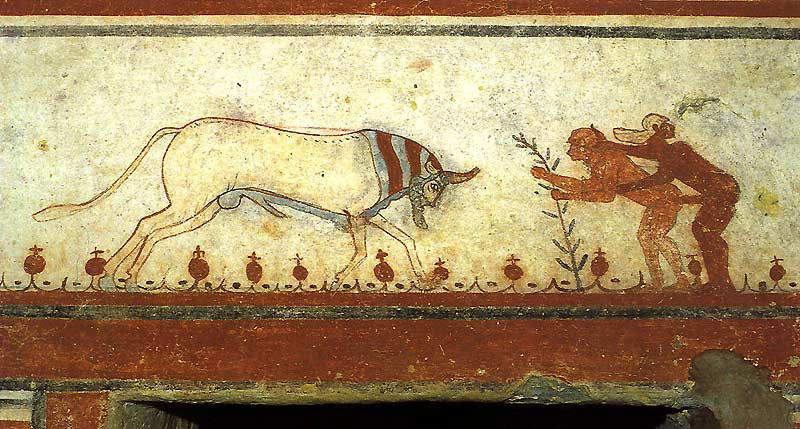 |
| Etruscan art, Scene of homosexual love (c. 530 BC; fresco; Tarquinia, Tomb of the Bulls) |
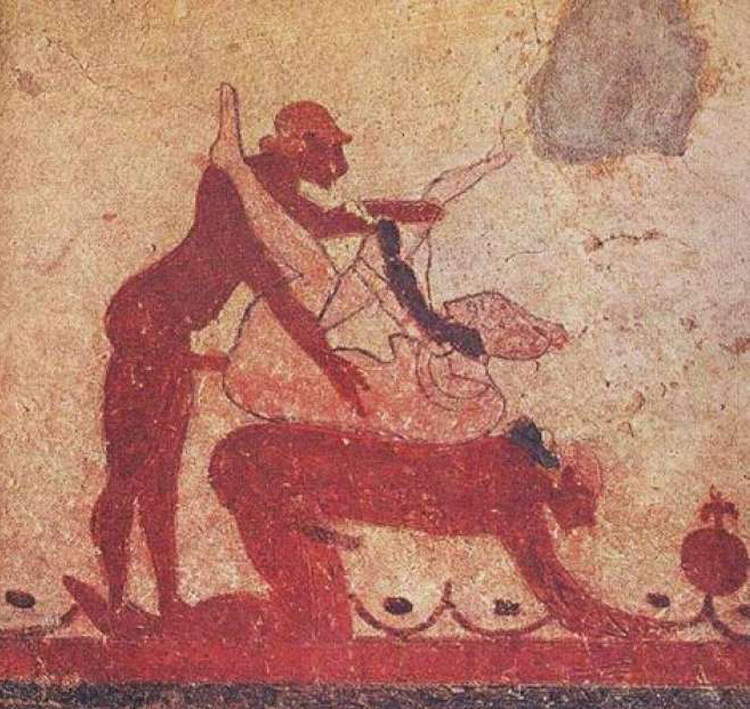 |
| Detail of heterosexual love scene in threesome |
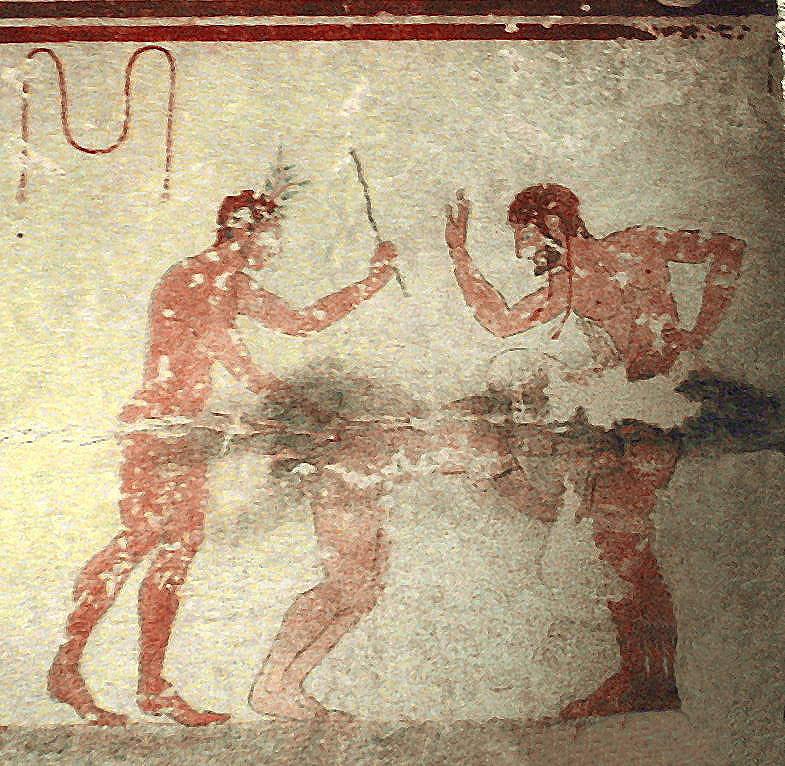 |
| Etruscan art, Erotic scene (5th century BC; fresco; Tarquinia, Tomb of the Flogging) |
That sex, for the Etruscans, had a good-luck and apotropaic function (and therefore, we imagine, they must have practiced it with great frequency) could perhaps explain why many works with scenes of various amplexes have survived, a kind of ante litteram pornography that, however, was probably accepted without problem at the time and was not meant to cause any scandal (erotic scenes, after all, are also found on a great many everyday objects). At the Antikensammlungen (Collections of Antiquities) in Munich there is an amphora of Greek production, but found at Vulci (thus presumably an object made to be sold in Etruria), which depicts a komos, or an uninhibited ritual dance linked to Dionysian rites, which could often result in a sort of gangbang where men and women indulged, all together, in the wildest sex. In the vase made by the Greek potter (who, by the way, filled it with inscriptions that appear meaningless: a very frequent case in black-figure pottery) we see figures in unmistakable attitudes, and the ancients’ predilection for difficult positions is also confirmed: just look at the couple with the man standing, holding the full weight of the woman on his thighs, and she rests her legs on his shoulders. We find the same, acrobatic position in an Etruscan amphora preserved at the Metropolitan Museum in New York, and decorated with a symplegma where we see copulation between a bearded man and a woman clinging to him.
We observe less strenuous amplexes in the so-called Tragliatellaoinochoe, a jug that was used to pour wine into the goblets of diners and so called because it was found, in 1878, in the necropolis of Tragliatella in Cerveteri (today, however, it is kept in the Capitoline Museums in Rome). This is a very ancient Etruscan vase, in that it dates from between the eighth and seventh centuries B.C. Here, we see two couples making love in a quiet missionary position (above, in the classic “version” that has the woman with her legs stretched out, below in the variant with her legs raised above the man’s shoulders). Since the myth of Theseus is depicted in the oinochoe, the two erotic scenes could allude to the love between Theseus and Ariadne. We then find another “classical” sexual position in a fragment of a cup preserved at the National Etruscan Museum in Chiusi: there, the two protagonists, man and woman, are engaged in what in English we call doggy style, and the peculiarity lies in the fact that the figures are in relief. It is, in fact, a Calenian pottery (that is, produced in ancient Cales, in Campania, near Capua), which was distinguished because the decorations were stamped and then painted black. There is also no shortage of scenes of homosexual love: we have one painted on a fifth-century amphora, preserved in the National Archaeological Museum in Naples, in which two young men intent on anal sex are depicted.
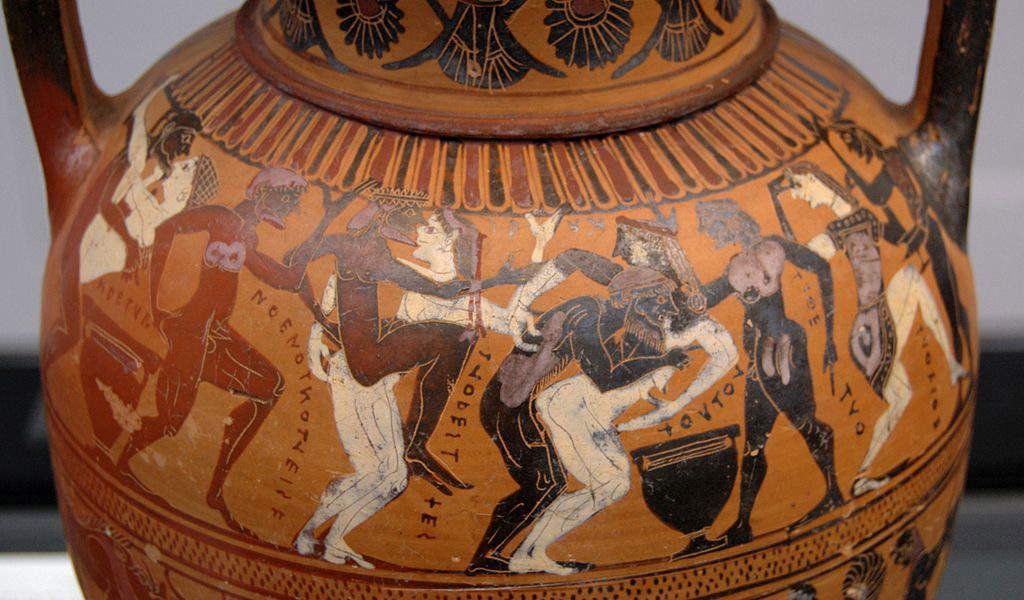 |
| Etruscan art, Amphora with komos (c. 560 BC; black-figure pottery; Munich, Antikensammlungen) |
 |
| Etruscan art, Amphora with symplegma (c. 530-525 BC; black-figure pottery, height 32.4 cm; New York, Metropolitan Museum) |
 |
| Etruscan art, Tragliatella vase decoration (8th-7th century BC; pottery; Rome, Capitoline Museums) |
 |
| Etruscan art (Cales production), Cup with erotic scene (late 6th century BC; pottery; Chiusi, National Etruscan Museum) |
 |
| Etruscan-Campanian art, Amphora with erotic scene (5th century BC; black-figure pottery; Naples, National Archaeological Museum) |
Finally, the judgment of contemporaries on the sexual conduct of the Etruscans deserves a mention. The longest (and also strictest) testimony that has remained with us is that of the Greek Theopompus: the author maintained that sexual promiscuity prevailed among the Etruscans, that women did not consider it disreputable or strange to appear naked in public, and that they often did not stay in the company of their husbands, but of whomever they wished. And about men, too, Theopompus had much to complain about, portraying the occasions of conviviality among the Etruscans as unrestrained orgies where everyone mated with everyone (slaves with prostitutes, husbands with wives, wives with young men brought in especially for the occasion, husbands with harlots): “it is not reprehensible for the Tyrrhenians to be seen indulging in sexual acts in public, nor even to undergo them, this also being a custom of the country. They are so alien from considering this conduct shameful that when the master of the house is making love and you ask about him, they say, ’He does this or that,’ giving such an occupation its true name. At social or kinship gatherings, they conduct themselves as follows: first when they have finished drinking and are disposed to sleep, the servants let in when the torches are still lit now courtesans, now beautiful young men and sometimes their wives. After satisfying their lusts with one or the other, they make vigorous young men lie down with these and those. They make love and give themselves to their pleasures sometimes in each other’s presence, but more often surrounding their beds with screens made of woven branches, over which they spread cloaks. They certainly have frequent intercourse with women but sometimes they amuse themselves with boys and young ephebes, who in their country are beautiful to behold because they live in luxury and have shaved bodies.” Another Greek historian, Timaeus, tells how it was customary at banquets for female slaves to serve men completely naked. The great Aristotle, in contrast to Theopompus, noted that the Etruscans used to lie with their wives.
Of course: we can avoid taking literally what the Greek historiographers tell us, because of their unquestioned bias (Theopompus’ assertions, in particular, are now commonly regarded as lying and malicious). From the artistic evidence we cannot establish with certainty what the sexual mores of the Etruscans were, but it is likely that they were far less uninhibited than we are depicted by Greek historiography: depictions of couples and spouses are very usual in works of art, while scenes of orgies and various festivities appear less frequently. It is then highly probable that prostitution was also widespread in Etruria and that certain banquets could turn into red-light parties: however, it is exaggerated to assume that similar behaviors were somehow inherent to the Etruscans and were proper to their entire society. But it is nonetheless conceivable that the Etruscans enjoyed a certain sexual freedom, fostered also by their religious beliefs, which certainly did not punish sex done for pure pleasure (on the contrary: sex was an important component of certain rituals, as we have seen), and as a result, probably encouraged them to have sex regularly and passionately. And in this, too, our ancestors were ... extremely modern.
Reference bibliography
Warning: the translation into English of the original Italian article was created using automatic tools. We undertake to review all articles, but we do not guarantee the total absence of inaccuracies in the translation due to the program. You can find the original by clicking on the ITA button. If you find any mistake,please contact us.